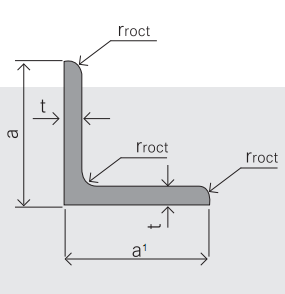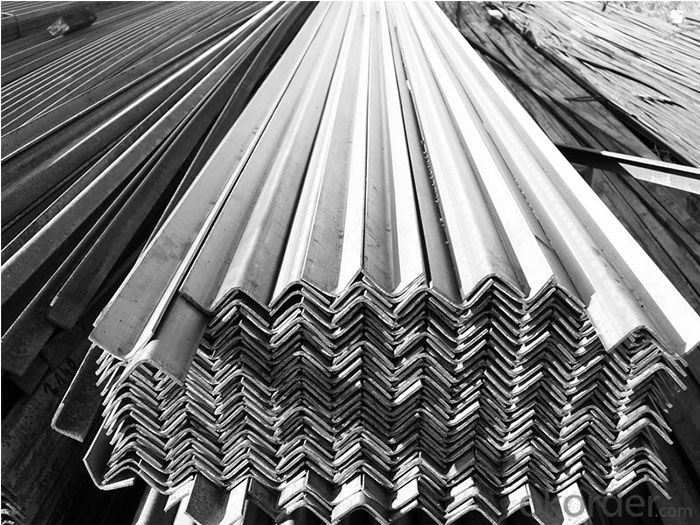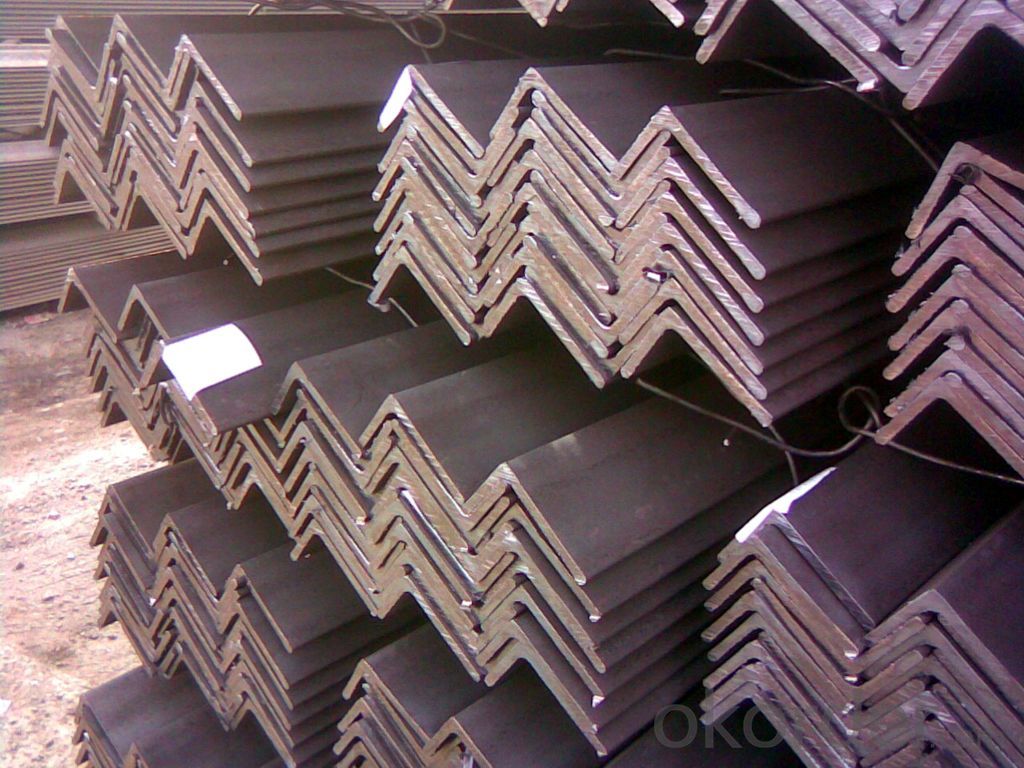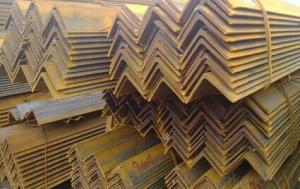A90*90*8 Equal steel Angle for construction
- Loading Port:
- Tianjin
- Payment Terms:
- TT OR LC
- Min Order Qty:
- 25 m.t.
- Supply Capability:
- 10000 m.t./month
OKorder Service Pledge
OKorder Financial Service
You Might Also Like
Product Description:
Specifications of Equal Steel Angle
1. Standards: GB,ASTM,BS,AISI,DIN,JIS
2. Length:6m,9m,12m
3. Material:Material: GB Q235B, Q345B or Equivalent; ASTM A36; EN 10025, S235JR, S355JR; JIS G3192,
SS400; SS540.
4. Sizes:

Sizes: 25mm-250mm | ||
a*t | ||
25*2.5-4.0 | 70*6.0-9.0 | 130*9.0-15 |
30*2.5-6.6 | 75*6.0-9.0 | 140*10-14 |
36*3.0-5.0 | 80*5.0-10 | 150*10-20 |
38*2.3-6.0 | 90*7.0-10 | 160*10-16 |
40*3.0-5.0 | 100*6.0-12 | 175*12-15 |
45*4.0-6.0 | 110*8.0-10 | 180*12-18 |
50*4.0-6.0 | 120*6.0-15 | 200*14-25 |
60*4.0-8.0 | 125*8.0-14 | 250*25 |
5. Material details:
Alloy No | Grade | Element (%) | |||||
C | Mn | S | P | Si | |||
|
|
|
|
|
|
| |
Q235 | B | 0.12—0.20 | 0.3—0.7 | ≤0.045 | ≤0.045 | ≤0.3 | |
|
|
|
|
|
|
| |
Alloy No | Grade | Yielding strength point( Mpa) | |||||
Thickness (mm) | |||||||
≤16 | >16--40 | >40--60 | >60--100 | ||||
≥ | |||||||
|
|
|
|
|
| ||
Q235 | B | 235 | 225 | 215 | 205 | ||
Alloy No | Grade | Tensile strength (Mpa) | Elongation after fracture (%) | ||||
Thickness (mm) | |||||||
| ≤16 | >16--40 | >40--60 | >60--100 | |||
≥ | |||||||
|
|
|
|
|
|
| |
Q235 | B | 375--500 | 26 | 25 | 24 | 23 | |
Usage & Applications of Equal Steel Angle
Trusses;
Transmission towers;
Telecommunication towers;
Bracing for general structures;
Stiffeners in structural use.
Packaging & Delivery of Equal Steel Angle



- Q:How do steel angles contribute to the overall stability of a building frame?
- Steel angles contribute to the overall stability of a building frame by providing structural support and reinforcement. They are commonly used as braces and connections in building frames to increase their load-bearing capacity and resist forces such as wind, earthquakes, and heavy loads. The angles help distribute and transfer the loads throughout the structure, enhancing its stability and preventing deformation or collapse.
- Q:Can steel angles be used in the construction of oil refineries?
- Yes, steel angles can be used in the construction of oil refineries. Steel angles are commonly used in structural applications due to their strength and versatility. They can provide structural support, reinforce connections, and enhance the overall stability of the refinery infrastructure.
- Q:What are the different grades of steel used in manufacturing steel angles?
- The different grades of steel used in manufacturing steel angles vary depending on the specific requirements and intended applications. Some common grades include A36, A572, and A588. A36 is a low carbon steel that is often used in general structural applications. A572 is a high-strength, low-alloy steel that is commonly used in construction and engineering projects. A588 is a weathering steel that is known for its corrosion resistance and is often used in outdoor structures.
- Q:What size does angle iron 125*10 mean?
- The sides are 125*125*10MM thick and the theoretical weight is 19.133 per meter
- Q:Are steel angles prone to rust or corrosion?
- Yes, steel angles are prone to rust or corrosion. Steel, when exposed to oxygen and moisture, can undergo a chemical reaction called oxidation, resulting in the formation of iron oxide, commonly known as rust. This process can weaken the structural integrity of the steel angles over time. To prevent or minimize rust or corrosion, steel angles are often coated with protective layers, such as paint, galvanization, or other anti-corrosion treatments. Regular maintenance and inspection are also crucial to identify and address any signs of rust or corrosion early on to prolong the longevity and performance of steel angles.
- Q:What are the different types of surface finishes available for steel angles?
- There are several types of surface finishes available for steel angles, including hot-dip galvanized, painted, mill finish, and blackened.
- Q:What are the common welding techniques for steel angles?
- The common welding techniques for steel angles include shielded metal arc welding (SMAW), gas metal arc welding (GMAW), and flux-cored arc welding (FCAW).
- Q:What are the different grades of steel used for manufacturing steel angles?
- Manufacturing steel angles involves the use of various grades of steel. These grades include: 1. Mild Steel: This is the most frequently utilized grade for producing steel angles. It boasts a low carbon content and is reasonably priced. Mild steel angles are suitable for a wide range of applications and possess excellent weldability and formability. 2. High-strength low-alloy (HSLA) steel: This grade incorporates small quantities of alloying elements such as copper, vanadium, or niobium, which augment its strength and toughness. HSLA steel angles are commonly employed in structural applications that demand high strength and durability. 3. Stainless Steel: Stainless steel angles are crafted from alloys that contain a significant chromium content, offering outstanding resistance to corrosion. These angles find common usage in environments where corrosion poses a concern, such as coastal areas or chemical plants. 4. Carbon Steel: Carbon steel angles are comprised of a combination of iron and carbon, with carbon content typically ranging from 0.05% to 2.1%. The higher the carbon content, the stronger and harder the steel becomes. Carbon steel angles are frequently employed in construction and machinery manufacturing. 5. Alloy Steel: Alloy steel angles are created by introducing various alloying elements like manganese, nickel, chromium, or molybdenum into carbon steel. These additions enhance the strength, hardness, and resistance to wear and corrosion of the steel. Alloy steel angles find common usage in heavy-duty applications like mining equipment or industrial machinery. The selection of steel grade for manufacturing steel angles depends on the specific requirements of the application, including desired strength, durability, corrosion resistance, and cost considerations.
- Q:Can steel angles be used for soundproofing applications?
- No, steel angles cannot be used for soundproofing applications.
- Q:What are the different types of steel angle profiles?
- There are several different types of steel angle profiles, each with its own unique characteristics and applications. Some of the most common types include: 1. Equal angle: This type of steel angle has equal sides and is typically used for structural purposes, such as supporting beams or framing. It provides equal strength and stability in both directions and is often used in construction and manufacturing industries. 2. Unequal angle: As the name suggests, this type of steel angle has unequal sides. It is commonly used in applications where more strength is required in one direction, such as supporting shelves or bracing components. Unequal angle profiles are also used in the construction of bridges and buildings. 3. L-shaped angle: This type of steel angle has one side that is longer than the other, forming an L shape. It is commonly used as a support or bracket in various applications, including furniture manufacturing, automotive industry, and construction. 4. Slotted angle: Slotted angle profiles have holes or slots along the length of the angle, allowing for easy attachment and adjustment of components. They are often used in shelving units, workbenches, and storage systems, providing flexibility and versatility in design. 5. Stainless steel angle: Stainless steel angles are made from corrosion-resistant steel, making them suitable for applications in environments where moisture and harsh chemicals are present. They are commonly used in food processing, pharmaceutical, and chemical industries. 6. Galvanized angle: Galvanized steel angles are coated with a protective layer of zinc, which helps prevent corrosion and rusting. They are widely used in outdoor applications, such as fencing, signposts, and support structures, where exposure to weather elements is a concern. These are just a few examples of the different types of steel angle profiles available, each offering specific advantages and applications depending on the project requirements.
1. Manufacturer Overview |
|
|---|---|
| Location | |
| Year Established | |
| Annual Output Value | |
| Main Markets | |
| Company Certifications | |
2. Manufacturer Certificates |
|
|---|---|
| a) Certification Name | |
| Range | |
| Reference | |
| Validity Period | |
3. Manufacturer Capability |
|
|---|---|
| a)Trade Capacity | |
| Nearest Port | |
| Export Percentage | |
| No.of Employees in Trade Department | |
| Language Spoken: | |
| b)Factory Information | |
| Factory Size: | |
| No. of Production Lines | |
| Contract Manufacturing | |
| Product Price Range | |
Send your message to us
A90*90*8 Equal steel Angle for construction
- Loading Port:
- Tianjin
- Payment Terms:
- TT OR LC
- Min Order Qty:
- 25 m.t.
- Supply Capability:
- 10000 m.t./month
OKorder Service Pledge
OKorder Financial Service
Similar products
New products
Hot products
Related keywords





























